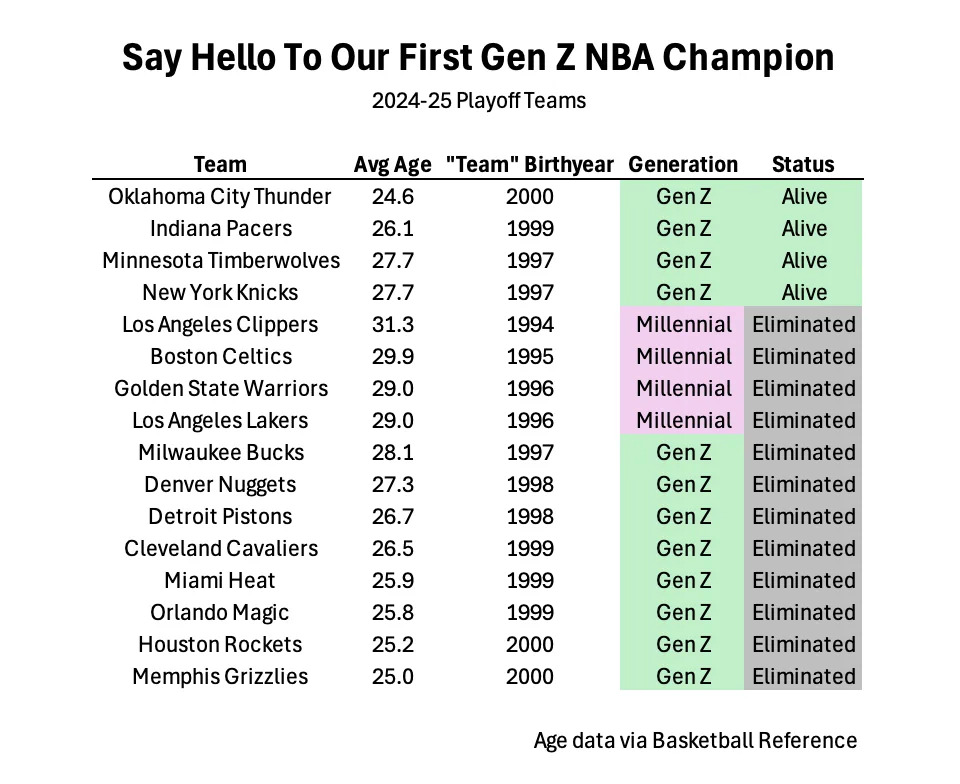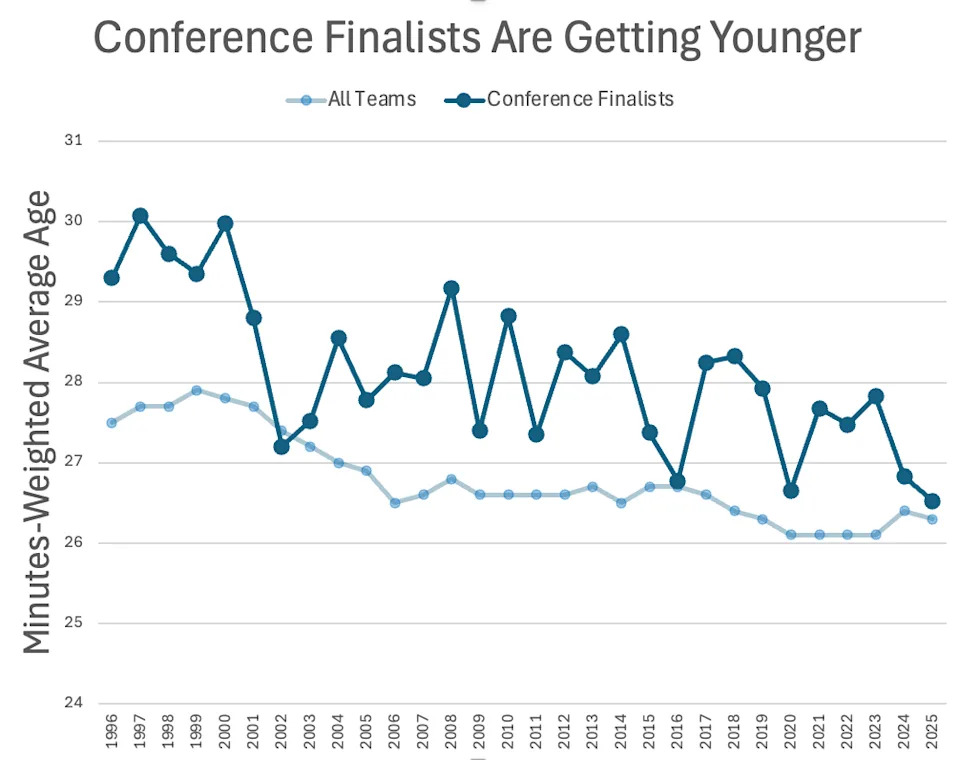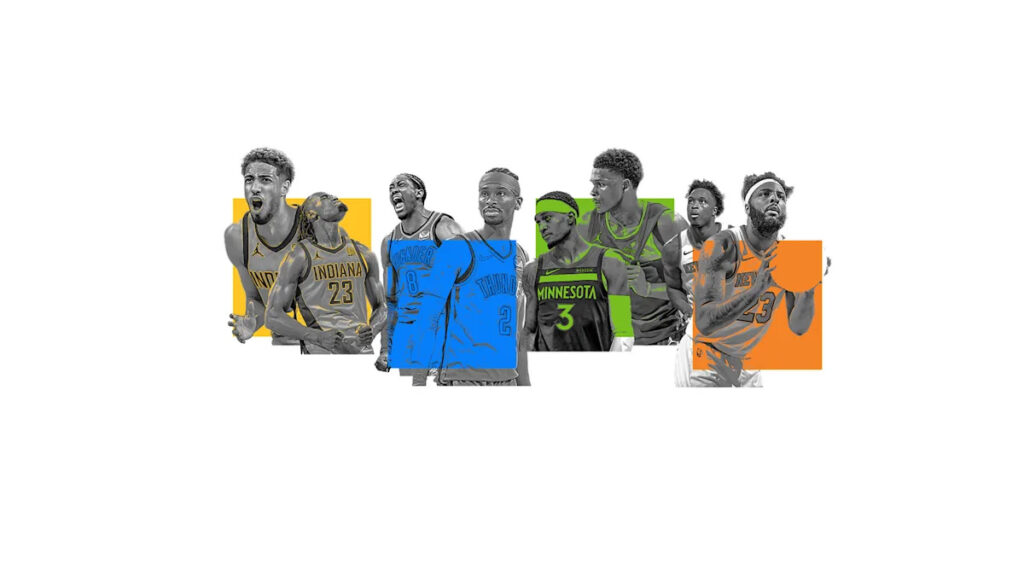When LeBron James made his NBA debut in 2003, Anthony Edwards was merely a toddler, taking his first steps on Earth. When Kobe Bryant threw the iconic ‘oop to Shaquille O’Neal in the 2000 Western Conference finals, Tyrese Haliburton was just a few months old. Jalen Brunson is young enough to ask his father, Rick, what it was like to play against Cleveland LeBron. Oh, and when Michael Jordan hit the clinching shot over Utah in the 1998 NBA Finals? Shai Gilgeous-Alexander wasn’t even born yet.
Feeling old yet?
Advertisement
Millennials certainly do.
But nothing made this millennial feel older than the following fact:
Now that the Boston Celtics have left the party, it is guaranteed that the 2025 NBA Finals winner will be the first Gen Z champion in league history.
Welcome to the Zoomers’ NBA.
Headlining these conference finals are four youthful teams whose franchises haven’t won a title in decades, if ever — and whose average age makes them too young to qualify for the millennial cohort. The rotations of the Oklahoma City Thunder, Indiana Pacers, New York Knicks and Minnesota Timberwolves hardly have any 30-year-olds.
Advertisement
The playoffs used to be the domain of older, savvy vets deep into their thirties, but the league has gotten younger, and the best teams seem to be aging in that direction more rapidly.
Is contending for a title increasingly becoming a young man’s game?
(Amy Monks/Yahoo Sports Illustration)
The first Gen Z champ
While there is no official separating line between Gen Z and millennials, leading think tank Pew Research Center has defined 1996 as the last birth year for the millennial generation based on their demographic work looking at technological, economic and social shifts throughout the last century. For the first time in NBA history, all four conference finalists — based on minutes-weighted average age, which accounts for playing time — will fit into the Gen Z category.
Advertisement
This postseason, the Celtics’ minutes-weighted average age was 29.9 years old, a birth year of 1995, making them the last millennial team that was remaining in the playoff field. The much younger and healthier Knicks squad (27.7) ousted them in six games after Jayson Tatum tore his Achilles in Game 4. (For the research study, ages are derived from Basketball Reference’s historical pages using a player’s age on Feb. 1 of the season.) If current trends hold, the Celtics will be the last millennial team to ever win the championship.
The kids are doing more than alright. Led by 26-year-old Gilgeous-Alexander, the Thunder’s minutes-weighted average age clocks in at 24.6 years old. That gives the West’s No. 1 seed a “team” birth year of 2000, three years after the 1997 cutoff for Gen Z. The 25-year-old Haliburton represents the face of the speedy Pacers, who, at an average of 26.1 years old, blitzed past the slightly more senior Cleveland Cavaliers (26.5) and Milwaukee Bucks (28.1) in earlier rounds. The Timberwolves, spearheaded by 23-year-old phenom Edwards, have an average age of 27.7 — the same as the Knicks, whose oldest rotation player is Josh Hart, who just turned 30.

If you’ve been paying attention, the NBA’s elder statesmen have all been kicked to the curb this postseason. There is no LeBron James, no Stephen Curry, no Jimmy Butler left. No Kevin Durant, who didn’t even make the play-in tournament. Not even Jrue Holiday, who won a title with both the Celtics and Bucks; the 34-year-old might as well be known as Uncle Jrue around some of the remaining youngsters.
Advertisement
Up 2-0 in the Western Conference finals, the Thunder are redefining everything that older generations thought they knew about what championship contenders look like. If OKC were to hoist the Larry O’Brien Trophy this season, it would be the second-youngest NBA champion ever, trailing only the 1977 Portland Trail Blazers (24.2) led by a 24-year-old Bill Walton. A modern precedent to these Thunder doesn’t really exist if they pull it off. The youngest championship team of the 21st century was the 2015 Golden State Warriors, who were 26.3 years old, almost two full years older than the current OKC squad.
With the Thunder leading the way, the average age of the four conference finalists stands at 26.5 years old, which is the lowest on record. In 1999, that same figure was 30 years old.

This continues a surprising trend that has seen the NBA get younger and younger in its final stages of the season. A Gen Z champion was only a matter of time, but if late 1990s roster trends held firm, we’d be about 2-3 years away from reaching that point. With these four teams, we’re way ahead of schedule.
Advertisement
While it’s true the league, in general, has gotten younger across the decades, the final four used to be far older than the also-rans. Nowadays, the age gap is narrowing to the point where, especially this season, there doesn’t seem to be much of one at all.
What’s going on?
Zooming out, this could be a function of injuries weeding out the old man. Last week, I pointed out the postseason is being riddled with injuries to star players more than ever. Heading into this postseason, the NBA averaged seven injured All-Stars over the previous five postseasons, a rate that has increased more than sevenfold since the late 1990s (0.8 per season).
Older stars like Stephen Curry (hamstring strain) and Damian Lillard (Achilles tear) were knocked out due to leg injuries while other veteran-led teams like the L.A. Clippers and L.A. Lakers only lasted a round.
Advertisement
Can millennial bodies still hold up and go the distance in today’s pace-and-space era? It’s a question that has gnawed at Steve Kerr.
The Warriors head coach was almost 33 years old when he won the 1998 NBA Finals as a player with Michael Jordan and the Chicago Bulls.
That’s roughly the same age as T.J. McConnell, the elder statesman of the Pacers who turned 33 in March. On that veteran-laden Bulls team, McConnell would have been just one of the guys. Scottie Pippen was 32. Jordan and Ron Harper were 34. Dennis Rodman was 36. The babies on the team were Toni Kukoc and Luc Longley, who were both 29 years old — the same age as Knicks “veteran” big Karl-Anthony Towns is now. The Bulls’ average age on that team was 32.1 years old. There’s not a single 32-year-old or older player on the OKC roster.
Kerr has taken notice.

Steve Kerr wonders if the schedule impacted Stephen Curry. (Photo by Ellen Schmidt/Getty Images)
(Ellen Schmidt via Getty Images)
When I asked Kerr to compare the league back then to now, the nine-time champion immediately pointed to the pace — the number of trips up and down the floor in each game. In the 1998 playoffs, the game was played at a snail’s pace, just 85 possessions per 48 minutes. Today, with teams favoring an uptempo playing style, playoff teams average about 95.
Advertisement
Kerr then points out how the 3-point shot — “the pace and space” — has broadened the physical demands of today’s defenders. It’s not just the frenetic pace of today’s game; it’s the expanding dimensions of bodily activity and psychological attention. He’s not totally surprised Curry, Lillard, Tatum and others have fallen victim to injury in today’s environment.
“Who’s more likely to be able to withstand the rigors of the pace and space and the game-every-other-day schedule — the younger players or the older players?” Kerr said.
“The younger guys are.”
Pace is indeed up, and according to player-tracking research, players are putting about 9% more mileage on the court per 48 minutes compared to a decade ago. Throw in the fact the NBA has wedged an in-season tournament and a play-in tournament into the schedule, and it’s hard to see where top vets can find enough recovery time.
Advertisement
“The most important point of all of this,” Kerr says, “is the pace and space and how much more mileage that players are covering. You see all these injuries … I don’t think players get enough rest anymore.”
Kerr, whose Warriors were ousted in the Western Conference semifinals, brings up the 37-year-old Curry, who lasted only 13 minutes in Game 1 of the series against the Timberwolves before his hamstring gave out, the first time in his 16-year career he suffered a hamstring strain.
It’s of Kerr’s belief the schedule was a significant factor to blame. It was Curry’s third playoff game in five days, with travel in between all three games. With the season on the brink, Kerr leaned on the two-time MVP for 42 minutes in Game 6 in San Francisco and a game-high 46 minutes in Game 7 in Houston. And then they traveled again, jetting up to Minnesota.
It’s a condensed workload that maybe a 27-year-old Curry might have been able to handle, but 37? In the aftermath of Curry’s injury, Kerr consulted his team doctors and performance staff. He asked Rick Celebrini, the team’s longtime director of sports medicine and performance, about the circumstances surrounding Curry’s first-time injury.
Advertisement
“Do you think Steph pulling his hamstring has anything to do with playing 48 hours after logging 46 minutes of Game 7 in Houston?” he asked.
“One hundred percent,” Kerr remembers Celebrini telling him. “If he had an extra day or two … we can’t prove this, but I have no doubt based on our understanding of the scientific literature that the hamstring injury was the result of inadequate recovery and fatigue.”
Kerr relents that it’s impossible to know what would have happened if the two rounds were more spaced out. But he certainly nodded along when he heard millennial and former NBA champion Aaron Gordon speak on the issue following his own hamstring injury. After the Denver Nuggets lost to the Thunder in the conference semifinals, Gordon was critical of the schedule that also required his Nuggets to play a Game 7 and Game 1 in a 48-hour span.
Advertisement
“I would really, really appreciate it if there were a couple of days in between games in the playoffs instead of every other day,” Gordon told reporters. “The product of the game would be a lot better. You’ll see a high level of basketball. Probably less blowouts.”
Kerr hopes the league takes action and either spaces out the existing schedule by adding a week to the season calendar or cutting regular season games. But in his discussions with the league both publicly and privately, he hasn’t gotten very far.
I think all the complaints of the wear and tear, and the scheduling, are all valid. But they all fall on deaf ears because of the dollar sign.
“I think all the complaints of the wear and tear, and the scheduling, are all valid,” Kerr says. “But they all fall on deaf ears because of the dollar sign. I don’t think the league’s constituents are willing to give up any money, that’s the problem. But we all know this is not healthy or sustainable if you want guys to survive out there and not have injuries.”
Teams around the league are studying the issue ahead of the draft and free agency. Said another longtime assistant coach: “Experience matters. So does strength. But with how the game is played, being able to move has skewed the importance more towards athleticism and youthful ability to recover more.”
Advertisement
Kerr hopes every stakeholder will look in the mirror — including coaches.
“We’ve got to try something,” Kerr says. “It’s going to take representatives from the players’ association, the coaches association, the owners, the league and the TV partners to actually acknowledge all of this.”
Kerr doesn’t want to take away from the terrific play — and superior health — of the remaining teams. He isn’t resistant to the idea of leaning on younger players — Golden State’s 22-year-old Brandin Podziemski was the youngest starter in the conference semifinal field. The Gen Z takeover is happening whether the millennials are ready or not.
Where does the league go from here?
With the Thunder being the odds-on favorite to win it all at BetMGM, it does seem like a generational shift is occurring before our very eyes. If younger teams are indeed outpacing their older foes, it holds important implications on long-term planning projections around the league.
Advertisement
That’s especially true for the teams hailing from the state of Texas. The Houston Rockets, whose 52-win core relied heavily on players barely of drinking age, may have reservations about giving up the farm for Durant, who turns 37 in September and has one year remaining on his contract with the Phoenix Suns. How much should they read into Butler’s fast decline in the postseason with the Warriors?
Up the road in San Antonio, the Spurs have already signaled they see Victor Wembanyama’s title window as appearing sooner than initially assumed. At the trade deadline, the team acquired 2022-23 All-NBA guard De’Aaron Fox to upgrade from the 40-year-old Chris Paul, who provided a steady hand as the team’s point guard. With Paul set to become a free agent, Harrison Barnes, 32, remains the team’s only player older than 27.
Advertisement
It’ll be fascinating to see how the Spurs complement Wemby, who missed half the season with deep-vein thrombosis. Do they put Stephon Castle and/or their No. 2 pick in the 2025 draft in a potential package for Giannis Antetokounmpo, who will be 33 years old by the time his contract expires in 2027-28?
And then there’s Dallas, which could make Golden State’s two-timeline experiment look timid by comparison. Does it make sense for Dallas to add an 18-year-old Cooper Flagg to a team anchored by a trio approaching their mid-30s in Kyrie Irving, Klay Thompson and Anthony Davis? Or does Dallas cut bait on the millennial core?
Despite Kerr’s misgivings about the rigors of the NBA season, it doesn’t seem like reform is on the way. Looking at the remaining teams in the postseason, it does seem like it’s a young man’s game now. Kerr feels conflicted in going that far.
“I wouldn’t put a blanket comment saying, ‘It’s a young man’s game,’ because in some ways that’s always been true,” Kerr says.
Advertisement
He gives it another thought.
“Maybe now,” he says, “they’re going to be taking over the league a little bit earlier than they were 10, 20 years ago.”
Read the full article here



